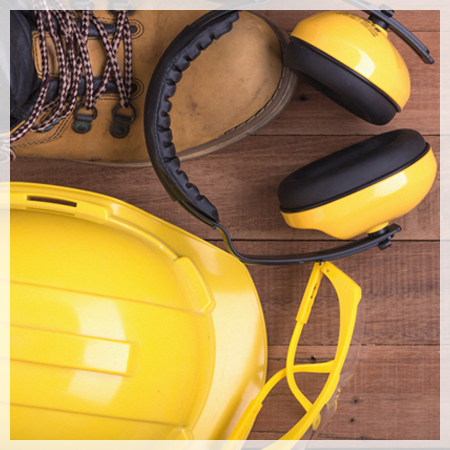Currency
July 30, 2017

PPE manufacturers discuss new technology, customer concerns and what’s on the horizon in their field.
Properly working and fitting personal protective equipment is critically important for workers, even if it’s meant to be used as the last line of defense. Safety+Health, with help from the International Safety Equipment Association, recently asked PPE manufacturers three questions:
What PPE trends are happening now, what challenges are your customers reaching out to you with, and what technological innovations are here or on the horizon?

“The most important factor is still choosing the right PPE for the job. An ongoing problem across all industries is that too many injury victims were not wearing the PPE supplied by their employer. The vast majority of reasons why people don’t wear PPE can, however, be easily addressed through good product design, the right materials, matching PPE to technical job specifications and informed purchasing decisions. Those designing, producing and purchasing PPE need to understand employees’ needs in terms of comfort and well-being, but also the demands of the job and the degree and nature of the hazards faced. One size does not fit all, and worker engagement and involvement during product development is critical.”
-- Norman Keane, glove program manager, D3O, Croydon, UK
“As manufacturers attempt to help reduce accidents between pedestrians and powered industrial trucks, I have seen a trend of increased use of high-visibility clothing inside the factory. While a safety vest is often the first garment considered, safety professionals may also consider garments that integrate high-visibility materials into work uniforms, such as high-visibility T-shirts and rental laundry work shirts. These garments can help reduce entanglement issues sometimes experienced with vests. While an ANSI/ISEA 107 Type R, Class 2 is the most commonly observed, safety professionals may also consider garments meetings the new ANSI/ISEA 107-2015, Type O for off-road use.”
– Shari Franklin Smith, senior technical service specialist – safety and health for food, beverage, agriculture and petrochemicals, 3M Personal Safety Division, 3M, St. Paul, MN
“Regulation changes can be especially choppy waters for safety managers to navigate, as new industry standards often can be both complex and indefinite. For example, gloves usually fall under the umbrella of general PPE, and the associated regulations are less stringent and sometimes voluntary – meaning some manufacturers may choose to abide by the new guidelines and some may not. Customers are looking more and more to manufacturers to be proactive in abiding with changing industry standards and provide guidance in selecting products that adhere to regulations while still providing performance and protection.”
– Steve Genzer, president and general manager, Ansell Industrial Solutions Global Business Unit, Ansell, Iselin, NJ
“Understanding the needs of the workforce by listening to end users is how manufacturers are developing innovative and technologically advanced products for head and face protection. Listening to what end users are saying and designing products that meet their needs is the No. 1 priority for manufacturers.”
– Stacey Simmons, product manager for industrial head and face protection, Bullard, Cynthiana, KY
Properly working and fitting personal protective equipment is critically important for workers, even if it’s meant to be used as the last line of defense. Safety+Health, with help from the International Safety Equipment Association, recently asked PPE manufacturers three questions:
What PPE trends are happening now, what challenges are your customers reaching out to you with, and what technological innovations are here or on the horizon?

“The most important factor is still choosing the right PPE for the job. An ongoing problem across all industries is that too many injury victims were not wearing the PPE supplied by their employer. The vast majority of reasons why people don’t wear PPE can, however, be easily addressed through good product design, the right materials, matching PPE to technical job specifications and informed purchasing decisions. Those designing, producing and purchasing PPE need to understand employees’ needs in terms of comfort and well-being, but also the demands of the job and the degree and nature of the hazards faced. One size does not fit all, and worker engagement and involvement during product development is critical.”
-- Norman Keane, glove program manager, D3O, Croydon, UK
“As manufacturers attempt to help reduce accidents between pedestrians and powered industrial trucks, I have seen a trend of increased use of high-visibility clothing inside the factory. While a safety vest is often the first garment considered, safety professionals may also consider garments that integrate high-visibility materials into work uniforms, such as high-visibility T-shirts and rental laundry work shirts. These garments can help reduce entanglement issues sometimes experienced with vests. While an ANSI/ISEA 107 Type R, Class 2 is the most commonly observed, safety professionals may also consider garments meetings the new ANSI/ISEA 107-2015, Type O for off-road use.”
– Shari Franklin Smith, senior technical service specialist – safety and health for food, beverage, agriculture and petrochemicals, 3M Personal Safety Division, 3M, St. Paul, MN
“Regulation changes can be especially choppy waters for safety managers to navigate, as new industry standards often can be both complex and indefinite. For example, gloves usually fall under the umbrella of general PPE, and the associated regulations are less stringent and sometimes voluntary – meaning some manufacturers may choose to abide by the new guidelines and some may not. Customers are looking more and more to manufacturers to be proactive in abiding with changing industry standards and provide guidance in selecting products that adhere to regulations while still providing performance and protection.”
– Steve Genzer, president and general manager, Ansell Industrial Solutions Global Business Unit, Ansell, Iselin, NJ
“Understanding the needs of the workforce by listening to end users is how manufacturers are developing innovative and technologically advanced products for head and face protection. Listening to what end users are saying and designing products that meet their needs is the No. 1 priority for manufacturers.”
– Stacey Simmons, product manager for industrial head and face protection, Bullard, Cynthiana, KY









